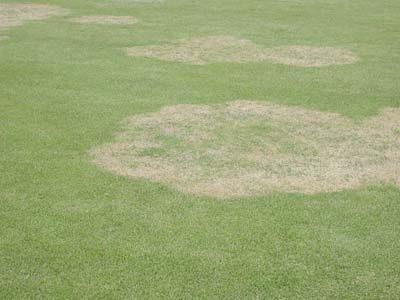As our zoysiagrass fairways and tees are greening up this spring, we will soon begin to see the symptoms of Rhizoctonia Large Patch (zoysia patch). Rhizoctonia Large Patch (RLP) is the only major disease of zoysiagrass in Indiana. The pathogen is favored by moderate temperatures and long dew periods in the spring, fall and during cool summers. Symptoms are seen on both dormant and actively growing zoysiagrass. Symptoms first start as small areas (12 inches) where leaf blades assume a tan-orange color. These patches can then expand rapidly into well-defined large patches (20 feet or more). There is no known resistance to Rhizoctonia Large Patch among zoysiagrass cultivars, but our current research suggests differences in susceptibility among the cultivars. Cultural practices such as reduced nitrogen and irrigation may help reduce RLP, but an application of fungicide is often justified for best control. Our research at Purdue shows that best RLP control results from strobilurin fungicides (Heritage, Compass, Insignia) or flutolanil (Prostar). Applying these fungicides in spring at about 50% zoysiagrass green-up provided good patch suppression. Midsummer and fall applications improved turf quality but were not as effective as spring applications. See the new extension publication (BP-117-W) linked below for more on biology and management of Rhizoctonia Large Patch.

More information about Rhizoctonia Large Patch is available at: http://www.extension.purdue.edu/extmedia/BP/BP-117-W.pdf